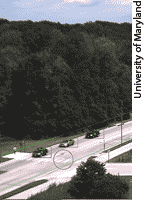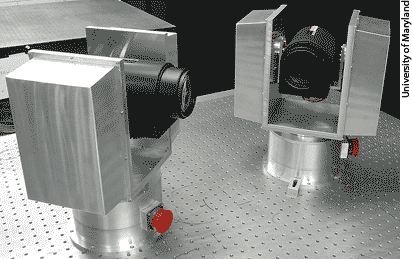U.S. Department of Transportation
Federal Highway Administration
1200 New Jersey Avenue, SE
Washington, DC 20590
202-366-4000
Federal Highway Administration Research and Technology
Coordinating, Developing, and Delivering Highway Transportation Innovations
| FACT SHEET |
| This fact sheet is an archived publication and may contain dated technical, contact, and link information |
| Publication Number: FHWA-HRT-15-068 Date: August 2015 |
Publication Number: FHWA-HRT-15-068 Date: August 2015 |
 |
The Exploratory Advanced Research Program Fact SheetPDF Version (400 KB) PDF files can be viewed with the Acrobat® Reader® Exploratory Advanced Research . . . Next Generation Transportation Solutions |
 Real-time video feature extraction. |
| Cameras are used prolifically to monitor transportation incidents, infrastructure, and congestion. Traditional camera systems often require human monitoring and only offer low-resolution video. Researchers for the Exploratory Advanced Research (EAR) Program project, “Cooperating Camera Platforms for Ultra-High-Resolution Traffic Surveillance and Autonomous Event Detection,” have developed a system that provides continuous, high-resolution, real-time simultaneous monitoring, tracking, and analysis of multiple events or characteristics. The University of Maryland is conducting this research, which was funded by the Federal Highway Administration (FHWA) in 2012. |
Enhanced Communications
Transportation infrastructures are traditionally monitored by cameras, often transmitting low-resolution live streaming images over dedicated wired networks or the Internet. A human is usually tasked with monitoring a poor quality feed on a screen that offers minimal automatic detection and follow-up capabilities. These video feeds are also transmitted to operation centers and then viewed on multiple screens on a rotational basis.
Researchers for this University of Maryland project have developed an advanced high-resolution video system that is not only capable of transmitting real-time high-resolution camera footage to remote operation centers, and to anywhere on a network on a "pop-up" basis as traffic events occur, but also can autonomously record a target's position, velocity, and identifying characteristics. The system uses cameras that can cooperate using precise and fast electronic pan, tilt, and zoom electronics for event detection and follow up. The introduction of multiple synchronized cameras that communicate such information about targets to each other in real time, with wide fields of view, over great distances, and at high resolution, represents a significant advance over current technology.
Coordinating Cameras
The research team has developed a system of coordinating cameras that can communicate with each other, zoom in, and then track significant events using servo-stabilized platforms. The high-resolution camera system offers powerful computer-controlled zoom capability, provides high-resolution imagery of highway infrastructure over ranges potentially up to 8 km (5 mi), and is capable of autonomously tracking objects that are moving extremely fast. The coordinating cameras can communicate information with each other about objects in their field of view every 50 milliseconds. This means that the system can be tasked with identifying a particular object of interest appearing in one camera view and that information can be transmitted to all of the other tracking cameras. The other cameras in turn pan and tilt to track the car when it comes into their view and record details from a distance, such as license-plate numbers and small zoomed-in high-resolution objects, if required.
Faster Wireless Communications
To meet the specific needs of this system, the research team developed a unique communications system that is capable of transmitting information to a command center, over hybrid wireless and wireline networks, at wireless data rates of up to 1-gigabit per second. The high-bandwidth communications network uses Internet technologies and systems to enable transmission of multiple complex events in high-resolution video in a fraction of a second. As a result, personnel in an operations center could be provided with immediate detection of events and first responders would remain connected with command posts to enable remote, instantaneous, and accurate situational assessments.

Cameras that can cooperate using precise and fast electronic pan, tilt, and zoom gimbals for event detection.
Improved Accuracy
The research team developed a new method to extract features or events from real-time video using an optical-based situational awareness approach. This method does not require the use of global positioning systems and enables an unrivalled level of accuracy to less than 5 cm (2 in). To achieve this accuracy, the camera lenses are specifically calibrated to provide improved long-range accuracy, potentially targeting cars that are many kilometers away. The cameras are mounted to specially developed, high-performance gimbals that are in turn calibrated with much higher precision than commercial systems. Although there are existing algorithms that can instruct a camera where to point, the calibrated gimbals in this project can perform to a far higher degree of accuracy and at much longer ranges than traditional approaches. In addition, the cameras and gimbals are calibrated in relation to their real-world positions. This enables the research team to incorporate map overlays with real-time traffic movement superimposed to provide a bird's eye visualization of feature extraction and events as they occur.
Highway Testing
The research team designed and developed a state-of-the-art testbed at the University of Maryland campus and on a local state highway. This setup emulates a highway monitoring system with deployed cameras and real-time, video-based, feature and event detection. Resulting information can be transmitted across campus and fed into an operations center in the research team's laboratory. During testing, the research team showed that an object can be automatically targeted in less than one second after it enters the field of view of the fixed camera and then successfully kept in the field of view of the steerable, zoomable cameras. All position, velocity, and identification updates are provided to the steerable camera in milliseconds. This testbed can be used for subsequent hardware, software, and algorithmic research, development, and evaluation.
Learn More
For more information on this project, contact Taylor Lochrane, FHWA Office of Operations Research and Development, at 202-493-3293 (email: taylor.lochrane@dot.gov).

|
What Is the Exploratory Advanced Research Program? FHWA's Exploratory Advanced Research (EAR) Program focuses on longer term, higher risk research with a high payoff potential. The program addresses underlying gaps faced by applied highway research programs, anticipates emerging issues with national implications, and reflects broad transportation industry goals and objectives. To learn more about the EAR Program, visit the Exploratory Advanced Research Web site at www.fhwa.dot.gov/advancedresearch/. The site features information on research solicitations, updates on ongoing research, links to published materials, summaries of past EAR Program events, and details on upcoming events. |
Publication No.
FHWA-HRT-15-068
HRTM-30/08-15(WEB)E